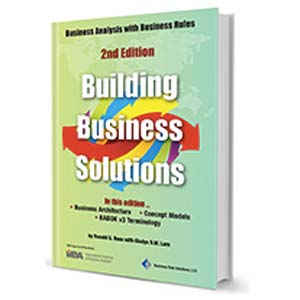SBVR: Ten Years and Still Ahead of Its Time!
Next month — January 2018 — marks the 10th anniversary of the publication of the Object Management Group's SBVR (Semantics of Business Vocabulary and Business Rules) version 1.0 specification.
From the day in October 2000, when the Business Rules Group began the very first work on SBVR, the vision for and purpose of SBVR has always been to enable the people who manage and run an organization to be able to express their business policies, business rules, and other governance documentation unambiguously using the same natural language and vocabulary they use every day to communicate with each other. A second supporting goal was to express the same unambiguous meaning of the natural language business vocabulary and business rules in a standards-based, machine-readable format that has an interpretation in formal logic.
This purpose and scope of the SBVR specification was at the heart of the OMG RFP published in June 2003 that launched the "Business Rules Team" submission team, which created the specification that eventually because SBVR v1.0 in January 2008. The scope and purpose of SBVR is still the same today, as set forth in Clause 1 of each version — SBVR v1.4 being the current version.[1] Work is currently underway on SBVR v1.5 with the goal of reducing the number of outstanding issues to a minimum, so SBVR can be submitted to the ISO TC 37 Language and Terminology technical committee to become an ISO standard.
Only now are organizations starting to realize that there are substantial risks and lost-opportunity costs that are the direct consequence of governance documentation that is open to misinterpretation. One international pharmaceutical company narrowly avoided having one of its major manufacturing facilities shut down by the US FDA for non-compliance. The root cause analysis led back to business policies put in place to ensure compliance that were misinterpreted because of ambiguity.
The increasing quantity, complexity, and international reach of regulations — especially in the financial services, insurance, and pharmaceutical industries — is starting to motivate the management of organizations to count the cost of ambiguous governance documentation and actually do something about it. Almost every international financial services institution is struggling to find a practical way to document its unambiguous natural language interpretation of regulations and, even more importantly, the natural language business policies and rules put in place to ensure compliance with regulations. They are finding increasingly that models of IT system artefacts, even data dictionaries, simply will not do the job. This assessment is based on wide feedback from financial service institutions that have been trying to use the OMG's FIBO OWL operational reason engine models to remove ambiguity from the business language used by the organization.
Even the regulators are starting to realize the serious problems caused to whole industries because of ambiguity in regulations. The UK Financial Conduct Authority (FCA) has as part of its mission to "clarify" its regulations, which are published in its FCA Handbook.[2] The FCA is starting to consider using SBVR to remove ambiguity from the FCA Handbook.[3] This is particularly significant internationally as many country financial services regulators are looking to the FCA for proven innovation in regulatory practices.[4]
In addition to business management being slow to take up the responsibility for ensuring that their governance documents are unambiguous, the IT community has for 10 years failed to recognize the difference between:
- the model of the problem domain (e.g., ab airline; a financial service organization) — in the case of SBVR, the vocabulary and rules of the business as understood and shared by the people who run the business, and
- the model of the solution used as a resource in the problem domain (e.g., an airplane; a financial service IT system including its data structures).
The result of this failure to recognize this difference between a model of the problem space and IT system design artefacts (including data elements) has been repeated attempts by the IT community to use SBVR as a data modeling or data dictionary specification — and worst still to try to turn SBVR into such a specification in place of its specified scope and purpose. The reason more IT vendors have not implemented SBVR tools is this radical misinterpretation of the scope and purpose of SBVR. They rightly decided that the world did not need another data modeling standard!
Fortunately, a few thought leaders in the IT community are not only seeing the significance of this difference, but are also doing something about it. One example of this is the new Cameo Concept Modeler Plugin for Magic Draw, which includes an early version of a transform between its concept model (a model of business' perception of things the organization deals with and does) — which is very like the concept model part of SBVR — and Magic Draw logical data models, as well as operational OWL reasoning-engine models (both as models of IT system components).
The future for SBVR is very bright, especially in the field of regulatory compliance, if both the business community and the IT community will step up to the reality that a model of how the people who operate the organization perceive their organization and what it deals with — as reflected by the meanings (concepts) they intend for the words they use when they communicate — is a very different thing from a model of an IT system designed to support the operation of the organization.
Realizing this bright future for SBVR can happen relatively quickly if the management in each community will take some key actions:
Management in Business Community
- To minimize risks from, and maximize operating efficiencies inhibited by, misinterpretation of governance documents, establish:
- a knowledge management capability to create and maintain an SBVR Terminological Dictionary, which includes business concept model, containing an agreed unique meaning for each term included in a given context; and
- a business process management capability to document unambiguous business policy and business rule statements using the SBVR Terminological Dictionary.
- Provide document authoring capability — e.g., as an add-in to Microsoft Word or an SBVR-aware HTML editor — to ensure creation of documents that are unambiguous because the author's intended definitions have been embedded behind the terms, and to keep the SBVR Terminological dictionary alive by constant use.
- Establish a way to specify business requirement data elements using the business meanings of business terms from the SBVR Terminological Dictionary and incorporate both the SBVR Terminological Dictionary and SBVR Rulebook as part of the purchase contract for IT system capability for use as a yardstick to measure the delivered IT system capability.
Management in IT Community
- Leverage the ontological and business rule intelligence in the SBVR Terminological Dictionary and SBVR Rulebook, on a read-only basis, as input to a partially-automated process for designing the IT system solution.
- Ensure that, in the delivered IT system, all the inputs from and all the outputs to the people who run the business of the organization have the business meaning as specified in the SBVR-based business requirements in the purchase contract and are captioned by the corresponding preferred business terms.
- Provide optional outputs from the IT system containing the same business meanings and captions so that business users can audit and validate any and every business computation in the IT system as needed.
- Ensure that the business-related system rules executed by the IT system, in whatever form, mean exactly what the business rules stated in the SBVR Rulebook in the purchase contract mean.
Whether we are running the business of the organization or designing and building IT systems to support that business, let's choose to value and respect the quite different roles and responsibilities of our colleagues in the other community as customers or suppliers. Let's work together through the business ↔ IT customer/suppler interface to use the unambiguous meanings business people intend for their terms and business rules, to enable IT systems to do the programmable part of tasks for business people exactly as the business desires, so they are more fully freed to use their creativity in running the business for benefit of its customers.
In addition to supporting unambiguous human communication among the people who run the organization, SBVR was designed so it could be the human communication cornerstone on the business side of the transformation bridge from the business of the organization as customer to the development and operation of IT systems as supplier to the business.
References
[1] Semantics of Business Vocabulary and Business Rules, v.1.4 @ http://www.omg.org/spec/SBVR/1.4/PDF![]()
[2] See FCA: Our Mission, Chapter 8, "Giving firms the confidence to be proactive." @ https://www.fca.org.uk/publication/corporate/our-mission-2017.pdf ![]()
[3] See https://www.fca.org.uk/firms/regtech/our-work-programme![]()
[4] See https://www.fca.org.uk/firms/innovate-and-innovation-hub/engagement ![]()
# # #
About our Contributor:
Online Interactive Training Series
In response to a great many requests, Business Rule Solutions now offers at-a-distance learning options. No travel, no backlogs, no hassles. Same great instructors, but with schedules, content and pricing designed to meet the special needs of busy professionals.













